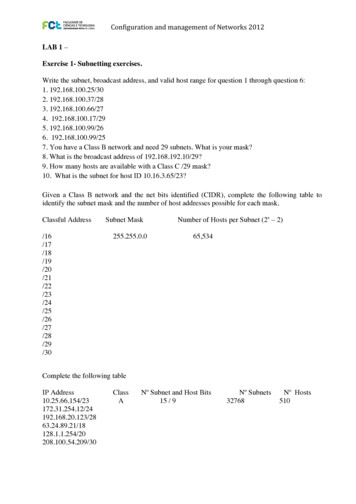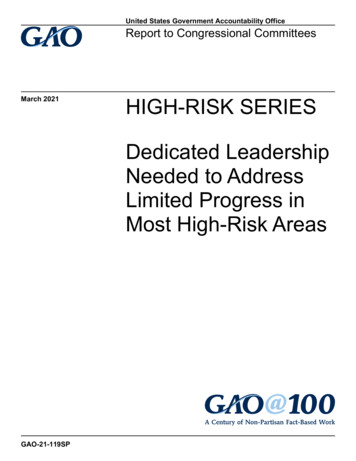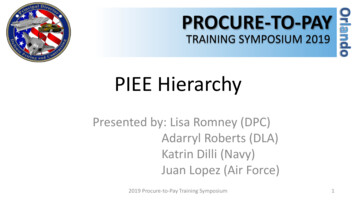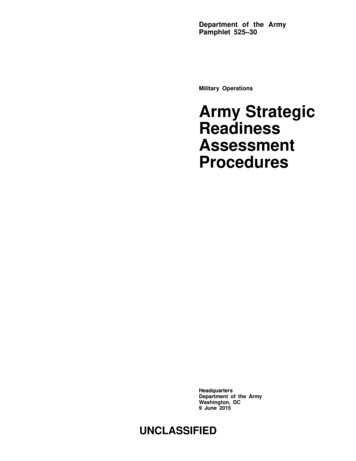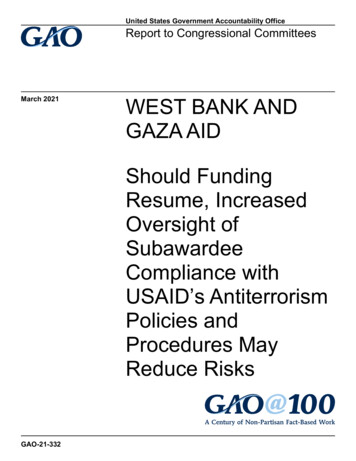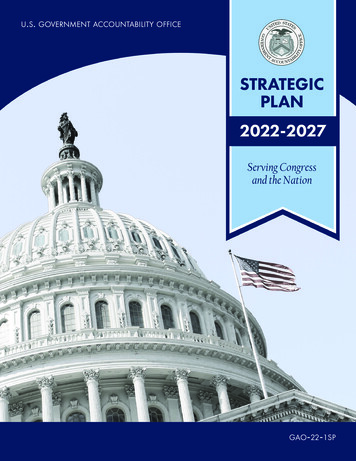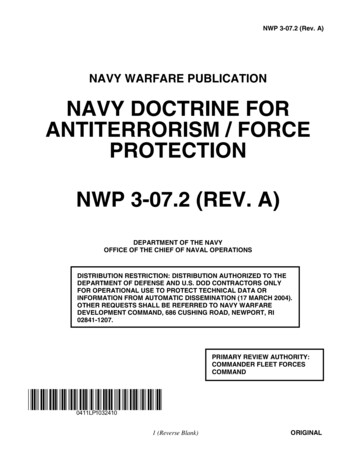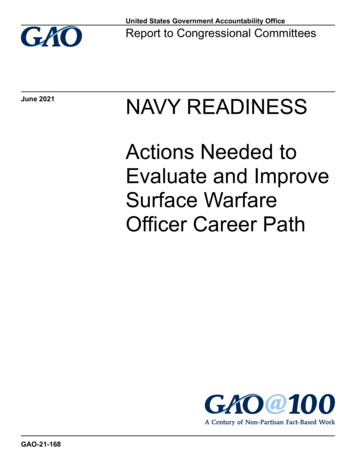
Transcription
United States Government Accountability OfficeReport to Congressional CommitteesJune 2021NAVY READINESSActions Needed toEvaluate and ImproveSurface WarfareOfficer Career PathGAO-21-168
June 2021NAVY READINESSActions Needed to Evaluate and Improve SurfaceWarfare Officer Career PathHighlights of GAO-21-168, a report tocongressional committeesWhy GAO Did This StudyWhat GAO FoundSWOs are U.S. Navy officers whoseprimary duties focus on the safeoperation of surface ships at sea. In2017, the Navy had two collisions atsea that resulted in the death of 17sailors and hundreds of millions ofdollars in damage to Navy ships.Following the collisions, the Navyidentified deficiencies in the SWOcareer path and staffing policies, andtook action to improve these areas.U.S. Navy Surface Warfare Officers (SWOs) separate from the SWO communityearlier and at higher rates compared with officers in similar U.S. Navycommunities, and female SWOs separate at higher rates than male SWOs.The John S. McCain NationalDefense Authorization Act for FiscalYear 2019 contained a provision thatGAO assess issues related to theU.S. Navy SWO career path. Amongother things, this report (1) assessestrends in separation rates of SWOswith those of similar U.S. Navy officercommunities, and trends in SWOseparation rates by gender; (2)describes how the career path of U.S.Navy SWOs compares to those ofselected foreign navies and otherU.S. Navy and U.S. maritimecommunities; and (3) assesses theextent to which the U.S. Navy hasused or evaluated alternative careerpaths. GAO analyzed U.S. Navyofficer personnel data; selectedforeign navies and U.S. maritimeofficer communities for comparison;and surveyed a generalizable sampleof Navy SWOs.Retention Rates for U.S. Navy Officers and Surface Warfare Officers by GenderNote: GAO compared the U.S. Navy Surface Warfare Officer community separation rates with thoseof the other unrestricted line officer communities in the U.S. Navy: Naval Aviation, Submarine, andExplosive Ordinance Disposal and Special Warfare.GAO found that after 10 years of service, around the first major career milestone: 33 percent of SWOs remain in their community, compared with 45 percent ofofficers from similar U.S. Navy officer communities, and12 percent of female SWOs remain in their community, compared with 39percent of male SWOs.By using existing information to develop a plan to improve SWO retention, theNavy will be better positioned to retain a diverse and combat-ready community.The career path for U.S. Navy SWOs differs from those in similar positions inselected foreign navies and other U.S. Navy and U.S. maritime communities.Career Path for U.S. Navy Surface Warfare Officers Compared with OthersWhat GAO RecommendsGAO is making 7 recommendationsto the Navy, including developing aplan to improve SWO retention;regularly evaluating its currentapproaches, including alternativecareer paths; and using these toimprove SWO career options andproficiency. The Navy concurred withGAO's recommendations.View GAO-21-168. For more information,contact Cary Russell at (202) 512-5431 orrussellc@gao.gov.The U.S. Navy made incremental career path changes for SWOs following the2017 collisions, but has not regularly evaluated or fundamentally changed itsSWO career path for over a century. GAO found that by a factor of four to one,SWOs believe specialized career paths would better prepare them for their dutiesthan the current generalist career path. Without periodic evaluations of currentapproaches, including alternative career paths, and the use of those evaluations,the U.S. Navy may miss an opportunity to develop and retain proficient SWOs.United States Government Accountability Office
ContentsLetter1BackgroundSWOs Separate Earlier and at Higher Rates Compared withOfficers in Similar U.S. Navy Communities, and Female SWOsSeparate at Higher Rates than MalesThe U.S. Navy’s Commissioning Practices Limit Surface WarfareOfficer Training Opportunities aboard ShipsThe Career Path for U.S. Navy SWOs Differs from Officers inSelected Foreign Navies and Other U.S. Navy and U.S.Maritime CommunitiesThe U.S. Navy Has Recently Made Incremental Career PathChanges for SWOs, but Has Not Regularly EvaluatedAlternative Career Path and Proficiency ModelsConclusionsRecommendations for Executive ActionAgency Comments and Our Evaluation37484951Appendix IData Sources and Methods Used for Retention Analyses54Appendix IINominal Cost of the U.S. Navy Surface Warfare, Aviation, andSubmarine Officer Career Paths73Appendix IIIForeign Navy and U.S. Maritime Organization Profiles78Appendix IVSurface Warfare Officer Survey Questionnaire, DemographicInformation, and Weighted Responses113Appendix VObjectives, Scope, and Methodology138Appendix VIComments from the Department of the Navy151Page i6101928GAO-21-168 Navy Readiness
Appendix VIIGAO Contact and Staff Acknowledgments170TablesTable 1: Summary of the Career Path Models for the U.S. Navy,Selected Foreign Navies, and the U.S. Coast GuardTable 2: Characteristics of Commissioning Programs and ShipDriving Training for Surface Warfare Officer Equivalentsamong the U.S. Navy, Selected Foreign Navies, andOther U.S. Navy and U.S. Maritime CommunitiesTable 3: Characteristics of Retention Practices for SurfaceWarfare Officer Equivalents among U.S. Navy, SelectedForeign Navies, and Other U.S. Navy and U.S. MaritimeCommunitiesTable 4: Population Count of the U.S. Navy Unrestricted LineOfficer Communities from July 2003 through March 2020Table 5: Demographic Composition of the U.S. Navy SurfaceWarfare Officer (SWO) Community Compared with OtherU.S. Navy Unrestricted Line (URL) Officer CommunitiesTable 6: Average Years of Service from Commissioning toSeparation by U.S Navy Officer Community andAccession SourceTable 7: Number and Percent of Male and Female U.S. NavySurface Warfare Officers (SWOs) during Calendar Years2003 through 2020Table 8: U.S. Navy Surface Warfare Officer (SWO) Community10-year Retention Rate Compared with other U.S. NavyUnrestricted Line (URL) Officer CommunitiesTable 9: U.S. Navy Surface Warfare Officer Retention RatesUsing the Life Table MethodTable 10: U.S. Navy Submarine Officer Retention Rates Using theLife Table MethodTable 11: U.S. Navy Aviation Officer Retention Rates Using theLife Table MethodTable 12: U.S. Navy Explosive Ordinance Disposal and SpecialWarfare Retention Rates Using the Life Table MethodTable 13: Male U.S. Navy Surface Warfare Officer RetentionRates Using the Life Table MethodTable 14: Female U.S. Navy Surface Warfare Officer RetentionRates Using the Life Table MethodTable 15: Bivariate Regression Results from Cox ProportionalHazard ModelPage ii293536555758586061626364656668GAO-21-168 Navy Readiness
Table 16: Multivariate Regression Results from Cox ProportionalHazard ModelTable 17: Nominal Per-Officer Costs of the U.S. Navy SurfaceWarfare, Aviation, and Submarine Officer Career Pathsthrough 23 Years of Commissioned ServiceTable 18: Survey-Based Estimates of U.S. Navy Surface WarfareOfficers Demographic InformationTable 19: Survey-Based Estimates Regarding the Number ofSurface Warfare Officer (SWO) Commanding OfficersU.S. Navy SWOs Have Worked For (n 343)Table 20: Survey-Based Estimates Regarding the Effectiveness ofGeneralist Career Path in Developing U.S. NavyCommanding OfficersTable 21: Survey-Based Estimates Regarding Opportunities toDevelop the Skills Needed to Perform Proficiently as aSurface Warfare Officer (SWO) (n 340)Table 22: Survey-Based Estimates Regarding What Career PathSurface Warfare Officers (SWOs) Believe Would BestPrepare SWOs For Their Service in the United StatesNavyTable 23: Survey-Based Estimates Regarding Surface WarfareOfficers (SWO) Personal Preference of a Career PathOptionTable 24: Survey Responses from Junior Surface WarfareOfficers: How Likely Would You be to Continue yourCareer After You Have Satisfied Your Current ServiceRequirement?Table 25: Survey-Based Estimates from U.S. Navy SurfaceWarfare Officers Who Have Not Served as CommandingOfficers on their Desire to Become a Commanding OfficerTable 26: Sample Design and Number of ure 1: Overview of Significant Mishaps at Sea for U.S. NavySurface Ships, January–August 2017Figure 2: Type and Number of U.S. Navy Surface Ships, as ofApril 2021Figure 3: Career Progression and Key Duties U.S. Navy SurfaceWarfare Officers (SWOs) Perform Aboard ShipsPage iii789GAO-21-168 Navy Readiness
Figure 4: Retention Rates for Officers in Select U.S. NavyCommunities, by Years of Service, Fiscal Year 2004through March 2020Figure 5: Nominal Personnel, Training, Retention, and MovingCosts of the U.S. Navy Surface Warfare Officer CareerPath through 23 Years of Commissioned ServiceFigure 6: Retention Rates for U.S. Navy Surface Warfare Officers,by Gender and Years of Service, Fiscal Years 2004through March 2020Figure 7: Female Representation in U.S. Navy Surface WarfareOfficer Community, Calendar Years 2004 through 2020Figure 8: U.S. Navy Surface Warfare Officer (SWO) Requirementsfor Ensigns aboard Ships and Ensign Over Execution,Fiscal Years 2017 through 2021Figure 9: Average Years of Experience on Surface Ships forNuclear-Trained and Non-Nuclear Trained SurfaceWarfare OfficersFigure 10: Selected Foreign Navies and U.S. MaritimeCommunities That Specialize Officer Career Paths byShip Department DutiesFigure 11: Selected Foreign Navy and U.S. Maritime CommunityThat Specialize Officer Career Paths by Ship TypeFigure 12: Survey-Based Estimates on What Career Path WouldBest Prepare U.S. Navy Surface Warfare Officers forDutyFigure 13: Survey-Based Estimates of U.S. Navy Surface WarfareOfficers Who Have Not Held Command on Whether TheyWould Like to Become Commanding OfficersFigure 14: Survey-Based Estimates of U.S. Navy Surface WarfareOfficer Personal Preference of Career PathFigure 15: O-1 to O-3 Grade U.S. Navy Surface Warfare Officers’Survey-Based Estimates of Likelihood of Retention ifPlaced in Various Career PathsFigure 16: Survey-Based Estimates of Observed Effectiveness ofCurrent U.S. Navy Surface Warfare Officer Career Pathin Developing Experienced Commanding OfficersFigure 17: Nominal Officer Costs for U.S. Navy Surface Warfare,Aviation, and Submarine Officer Community through 23Years of Commissioned ServiceFigure 18: Nominal Training Costs for U.S. Navy Surface Warfare,Aviation, and Submarine Officer Community through 23Years of Commissioned ServicePage iv111416182026313239414243447476GAO-21-168 Navy Readiness
Figure 19: Nominal Retention Costs for U.S. Navy SurfaceWarfare, Aviation, and Submarine Officer Communitythrough 23 Years of Commissioned ServiceFigure 20: French Navy Surface Warfare Officer Career Paths andShipsFigure 21: Nominal French Navy Surface Warfare Officer(Operations) Career PathFigure 22: Nominal French Navy Surface Warfare Officer(Engineering) Career PathFigure 23: French Navy Junior Surface Warfare Officer(Operations) Training ProgramsFigure 24: Italian Navy Surface Warfare Officer Career Paths andShipsFigure 25: Nominal Italian Navy General Staff Officer SurfaceFleet Career PathFigure 26: Nominal Italian Navy Naval and MechanicalEngineering Officer Career PathFigure 27: Nominal Italian Navy Weapons Engineering OfficerCareer PathFigure 28: Nominal Italian Navy Supply Officer Career PathFigure 29: Italian Navy Junior General Staff Officer SurfaceTraining ProgramsFigure 30: Japan Maritime Self-Defense Force—Category 1Surface Warfare Officer Career Paths and ShipsFigure 31: Nominal Japan Maritime Self-Defense Force SurfaceWarfare Officer Career PathFigure 32: Japan Maritime Self-Defense Force Junior Category 1Surface Warfare Officer Training ProgramsFigure 33: Republic of Korea Navy Surface Warfare Officer CareerPaths and ShipsFigure 34: Nominal Republic of Korea Navy Surface WarfareOfficer Career PathFigure 35: Republic of Korea Navy Junior Surface Warfare OfficerTraining ProgramsFigure 36: United Kingdom Royal Navy Surface Warfare CareerPaths and ShipsFigure 37: Nominal United Kingdom Royal Navy Warfare OfficerSurface Fleet Career PathFigure 38: Nominal United Kingdom Royal Navy Engineer OfficerCareer PathFigure 39: UK Royal Navy Junior Warfare Officer Surface TrainingProgramsPage 168 Navy Readiness
Figure 40: U.S. Navy Surface Warfare Officer Career Path andShipsFigure 41: Nominal U.S. Navy Surface Warfare Officer CareerPathFigure 42: U.S. Navy Junior Surface Warfare Officer Ship-DrivingTraining ProgramsFigure 43: U.S. Naval Aviation Officer Career Path and ShipsFigure 44: Nominal U.S. Naval Aviation Officers Career PathFigure 45: Ship-Driving Training for U.S. Naval Aviation OfficersFigure 46: U.S. Navy Submarine Officer Career Path andSubmarinesFigure 47: Nominal U.S. Navy Submarine Officer Career PathFigure 48: U.S. Navy Junior Submarine Officer Training ProgramsFigure 49: Nominal U.S. Coast Guard Officer Career Paths andShipsFigure 50: Nominal U.S. Coast Guard Deck Watch Officer toOperations Afloat Career PathFigure 51: Nominal U.S. Coast Guard Student Engineer to NavalEngineer Career PathFigure 52: U.S. Coast Guard Deck Watch Officer Ship-drivingTraining reviationsDODSWOURLEODJMSDFROKUKDepartment of DefenseSurface Warfare OfficerUnrestricted LineExplosive Ordinance DisposalJapan Maritime Self-Defense ForceRepublic of KoreaUnited KingdomThis is a work of the U.S. government and is not subject to copyright protection in theUnited States. The published product may be reproduced and distributed in its entiretywithout further permission from GAO. However, because this work may containcopyrighted images or other material, permission from the copyright holder may benecessary if you wish to reproduce this material separately.Page viGAO-21-168 Navy Readiness
Letter441 G St. N.W.Washington, DC 20548June 17, 2021Congressional CommitteesIn 2017, the U.S. Navy surface fleet had four significant mishaps at sea,including two collisions that resulted in the death of 17 sailors andhundreds of millions of dollars in damage to U.S. Navy ships. 1 Followingthe incidents, the U.S. Navy completed two internal reviews to identifyand address the root causes of the mishaps. 2 In the reviews, the U.S.Navy identified challenges related to the Surface Warfare Officer (SWO)career path, particularly in officer development and the ability of the U.S.Navy to minimize the separation of SWOs—a term that refers to an officereither leaving the Navy or transferring to another officer community withinthe U.S. Navy. 3 SWOs are U.S. Navy officers whose training and primaryduties focus on the safe operation of U.S. Navy surface ships at sea,management of various shipboard systems, and the leadership of ships’crews. In response to the internal reviews, the U.S. Navy has undertakena number of efforts to improve the SWO career path.The John S. McCain National Defense Authorization Act for Fiscal Year2019 contained a provision that we review the U.S. Navy SWO careerpath to include comparing it to those of foreign navies. 4 This report (1)assesses the extent to which there are differences in separation rates forthe U.S. Navy SWO community and other U.S. Navy officer communities,and gender differences in separation rates for the U.S. Navy SWO1A“mishap” is an unplanned event or series of events that results in damage toDepartment of Defense (DOD) property; occupational illness to DOD personnel; injury toon- or off-duty DOD military personnel; injury to on-duty DOD civilian personnel; ordamage to public or private property, or injury or illness to non-DOD personnel, caused byDOD activities.2U.S.Navy, Comprehensive Review of Recent Surface Force Incidents, Oct. 26, 2017 andU.S. Navy, Strategic Readiness Review 2017, Dec. 3, 2017. The two reviews resulted in111 recommendations to improve surface fleet readiness.3Careerpath refers to the requirements and milestones such as training, experiences,qualifications, assignments, and promotions officers receive as they progress throughouttheir careers. According to the U.S. Navy, the ultimate goal of the SWO career path is todevelop the most proficient, experienced, and confident ship Commanding Officers. NavalOfficers are grouped into officer communities based on the work they do in the U.S. Navy.Examples of officer communities include Naval Aviation, Engineering Duty, Submarine,Naval Special Warfare, Physicians, Chaplains, and Public Affairs Officers.4Pub.L. No. 115-232, § 514 (2018).Page 1GAO-21-168 Navy Readiness
community; (2) assesses the extent to which U.S. Navy commissioningpractices affect SWO training opportunities aboard ships; (3) describeshow the career path of U.S. Navy SWOs compare to those of selectedforeign navies and other U.S. Navy and U.S. maritime communities; and(4) assesses the extent to which the U.S. Navy has used or evaluatedalternative career paths and means of developing proficiency for SWOs.For objective one, we obtained and analyzed personnel data from theDefense Manpower Data Center on officers across the U.S. Navy’sUnrestricted Line Officer 5 communities for fiscal year 2004 through March2020, including service start date, grade, gender, race, marital status, andwhether the officer has dependents. 6 We analyzed these data fordescriptive statistics to show trends and developed statistical models toexamine the likelihood that specific events would occur for variousdemographic characteristics. 7 We could not control for all factors that mayaffect separation, such as an officer’s performance and labor marketconditions. Therefore, our models provide information on possibleassociations in the data, and they do not establish a causal relationship.We discussed the results of our analyses with officials from Commander,Naval Surface Forces; Navy Personnel Command; the Office of the Chiefof Naval Operations; and the Defense Manpower Data Center.We assessed the reliability of U.S. Navy personnel data by reviewing therelevant data dictionary; interviewing knowledgeable officials from theDefense Manpower Data Center; and conducting both electronic andmanual data testing to look for missing and erroneous data. Based on ourassessments, we determined that the data used in our analyses aresufficiently reliable for the purposes of determining SWO separation rates,comparing them to those of other U.S. Navy officer communities, andassessing the extent to which there are gender differences in separationrates. We also collected nominal career path costs, as of February 2021,from officials in the Office of the Chief of Naval Operations, Surface5UnrestrictedLine Officers are not restricted in the performance of duty and are eligible tocommand Navy ships, submarines, aircraft squadrons, fleets, and shore bases.Conversely, Restricted Line Officers in the U.S. Navy are designated for specific duties—such as intelligence, public affairs, aviation maintenance, or oceanography. UnrestrictedLine Officers include Surface Warfare, Aviation, Submarine, Naval Special Warfare, andExplosive Ordinance Disposal Officers. These officers are commissioned through OfficerCandidate School, the Naval Reserve Officers Training Corps, or the Naval Academy.6Weselected July 2003 through March 2020 because this is the most recent time periodfor which DOD has complete data available and allows for a robust longitudinal analysis.7Forinformation about our descriptive and statistical analysis and models, see appendix I.Page 2GAO-21-168 Navy Readiness
Warfare Division, Air Warfare Division, and Undersea Warfare Divisionusing a standardized data request. We reviewed related documentation,checked the data for missing fields and erroneous data, and verified thedata with officials from each of the three divisions at Office of the Chief ofNaval Operations to ensure that their information was reliable andaccurately represented. We did not assess the U.S. Navy’s assumptionsunderlying the career path cost data provided nor did we adjust costs forinflation. We determined that the data were sufficiently reliable for thepurposes of reporting the nominal career path costs for the U.S. Navy’sSurface Warfare, Aviation, and Submarine officer communities.We determined that the control environment and risk assessmentcomponents of Standards for Internal Controls in the Federal Governmentwere significant to this objective, along with the underlying principles thatmanagement demonstrate a commitment to recruit, develop, and retaincompetent individuals and have plans with clearly defined goals,performance measures, and timelines. 8 We reviewed publications onfemale retention efforts in the military to determine what others had foundand recommended with regard to female retention in the military, as wellas our prior work on female officer retention in the military services. 9 Wecompared this information to documentation detailing U.S. Navy goalsand guidance that establishes responsibilities related to strategic humancapital planning and retention of a diverse workforce to identify anygaps. 10For objective two, we obtained and analyzed data on the required numberof Junior Officer positions aboard ships with the actual number of JuniorOfficers aboard ships for fiscal years 2017 through February 2021. Wealso reviewed information on junior SWO recruitment and trainingexpectations and discussed SWO commissioning practices and policieswith officials from Commander, Naval Surface Forces; Navy PersonnelCommand; and the Office of the Chief of Naval Operations. We assessedthe reliability of U.S. Navy personnel requirements data and actual counts8GAO,Standards for Internal Control in the Federal Government, GAO-14-704G(Washington, D.C.: Sept. 10, 2014).9DefenseAdvisory Committee on Women in the Services, 2015 Annual Report(December 2015) and GAO, Female Active-Duty Personnel: Guidance and Plans Neededfor Recruitment and Retention Efforts, GAO-21-61 (Washington, D.C.: May 19, 2020).10Office of the Chief of Naval Operations Instruction 5450.337B, Missions, Functions, andTasks of Commander, United States Pacific Fleet (Jan. 21, 2016) and Office of the Chiefof Naval Operations Instruction 5420.115, Navy Diversity Policy Coordination (Dec. 20,2012).Page 3GAO-21-168 Navy Readiness
of personnel by reviewing U.S. Navy guidance, interviewingknowledgeable officials from the U.S. Navy, and conducting bothelectronic and manual data testing to look for missing and erroneousdata. Based on our assessments, we determined that the personnelrequirements data used in our analyses were sufficiently reliable for thepurposes of reporting on U.S. Navy personnel requirements,commissioning practices, and personnel levels. We evaluated SWOcommissioning practices and policies against U.S. Navy guidance ontraining requirements and proficiency development, and our prior work onKey Principles for Effective Strategic Workforce Planning and Standardsfor Internal Control in the Federal Government. 11 We determined that therisk assessment component of internal controls was significant to thisobjective, along with the underlying principle that management identify,analyze, and respond to risks related to achieving the defined objectives.For objective three, we reviewed U.S. Navy documentation on thecontent, purpose, and cost of the SWO career path, and identified meansof comparing it with foreign navies and other U.S. Navy and U.S. maritimecommunities. 12 We discussed SWO policies with officials fromCommander, Naval Surface Forces; Navy Personnel Command; and theOffice of the Chief of Naval Operations. Based on this work, wedeveloped a standardized question set to support comparison of SWOcareer paths. We identified foreign navies with large surface fleets usingJane’s Fighting Ships database and, after selecting foreign navies forcomparison based on fleet size and other characteristics, we requestedthe participation of six navies. Five foreign navies—those of France, Italy,Japan, Republic of Korea, and the United Kingdom—agreed to participatein our review and provided official responses to our question set andrelated documentation. 13 We also compared the U.S. Navy SWO careerpath to those of U.S. Navy submarine and aviation officers, and U.S.11Commander, Naval Surface Force, U.S. Pacific Fleet and Commander, Naval SurfaceForce Atlantic Instruction 1412.9, Surface Warfare Mariner Skills Logbook Requirements(Sept. 6, 2018). GAO, Human Capital: Key Principles for Effective Strategic WorkforcePlanning, GAO-04-39 (Washington, D.C.: Dec. 11, 2003). GAO-14-704G.12See appendix II for more information about the nominal costs of the U.S. Navy SWO,U.S. Naval Aviation Officer, and U.S. Navy Submarine Officer career paths.13See appendix III for community profiles for Surface Warfare Officer equivalent officers inFrance, Italy, Japan, Republic of Korea, and the United Kingdom navies.Page 4GAO-21-168 Navy Readiness
Coast Guard officers using interviews and the same question set we sentthe foreign navies. 14For objective four, we reviewed U.S. Navy documentation on efforts toreview career path and proficiency development guidance, includingchanges made since the 2017 collisions and discussed U.S. Navy actionswith officials from Commander, Naval Surface Forces; Navy PersonnelCommand; and the Office of the Chief of Naval Operations. We alsoconducted a web-based survey of a generalizable, stratified randomsample of SWOs to assess their opinions on the current SWO career pathand potential changes to the SWO career path. 15 We defined the targetpopulation for this survey to include all active-duty SWOs, includingtrainees, grades O-1 to O-6. 16 Based on general information we providedon the survey, the U.S. Navy provided a list of all officers who met thepopulation definition, and we identified the sample frame of 8,606SWOs. 17We used information gathered during a related review of SWO training inwhich we visited 12 surface ships in the Pacific and Atlantic fleets,selected according to which ships and crews were available at each ofthe sites we visited. Aboard the ships we held group discussions andinterviews with approximately 225 SWOs to discuss their views on SWOcareer path and other SWO community policies. We compared the U.S.Navy’s actions in assessing the SWO career path and proficiency14See appendix III for profiles for U.S. Navy Surface Warfare, Aviation, Submarine, andCoast Guard communities.15Seeappendix IV for the questions included in the survey questionnaire.16Military officers have a personnel grade associated with their rank and pay ranging fromO-1 through O-10. In the U.S. Navy, the O-1 to O-6 grades include the main body ofofficers, from the ranks of Ensign at O-1 to Captain at O-6. Lower grades include juniorofficers in the U.S. Navy, representing the ranks of Ensign at O-1, Lieutenant (juniorgrade) at O-2, and Lieutenant at O-3. Middle grades include Department Heads,Executive Officers, and Commanding Officers in the U.S. Navy, representing the ranks ofLieutenant Commander O-4, Commander O-5 and Captain O-6. The O-7 to O-10 gradesinclude senior leadership, from the ranks of Rear Admiral (lower half) at O-7 to Admiral atO-10. 37 U.S.C. § 201(a).17We received responses from 351 of the 852 SWOs selected in our sample (41 percentresponse rate). The weighted response rate, which controls for the disproportionatesample design, was 38 percent. Based on the weighted response rate, we generatedweighted estimates to the population of 8,606 SWOs. Survey-based estimates included inthis report have a margin of error of plus or minus 10 percentage points or fewer, unlessotherwise noted. See appendix V for more information about our survey methodology.Page 5GAO-21-168 Navy Readiness
development policies against key principles for effective strategic humancapital planning. 18 Our scope and methodology are discussed in greaterdetail in appendix V.We conducted this performance audit from September 2019 to June 2021in accordance with generally accepted government auditing standards.Those standards require that we plan and perform the audit to obtainsufficient, appropriate evidence to provide a reasonable basis for ourfindings and conclusions based on our audit objectives. We believe thatthe evidence obtained provides a reasonable basis for our findings andconclusions based on our audit objectives.Background2017 Mishaps at SeaFrom January through August 2017, the U.S. Navy suffered foursignificant mishaps at sea that resulted in the death of 17 sailors andhundreds of millions of dollars in damage to U.S. Navy surface ships (seefig.1).18GAO-04-39. Office of the Chief of Naval Operations Instruction 5450.337B, Missions,Functions, and Tasks of Commander, United States Pacific Fleet (Jan. 21, 2016).Commander, Naval Surface Forces Instruction 1412.4A, Surface Warfare OfficerRequirements Document (Oct. 11, 2018).Page 6GAO-21-168 Navy Readiness
Figure 1: Overview of Significant Mishaps at Sea for U.S. Navy Surface Ships,January–August 2017The U.S. Navy completed two internal reviews to identify and address theroot causes of the mishaps—the Comprehensive Review of RecentSurface Force Incidents and the Strategic Readiness Review—finding aPage 7GAO-21-168 Navy Readiness
range of deficiencies and other issues related to development andproficiency of SWOs. 19U.S. Navy SurfaceWarfare Officers (SWOs)As of December 2020, the U.S. Navy had 8,925 SWOs—officers whosetraining and primary duties focus on the operation of U.S. Navy ships atsea and the management of various shipboard systems. 20 The U.S. NavySWO community has a generalist career path where officers can serve indifferent ship departments—such as engineering and ship operations—during their career. SWOs can also serve aboard any of the U.S. Navy’sten ship classes, including cruisers, destroyers, aircraft carriers, littoralcombat ships, and mine countermeasures ships. 21 Figure 2 provides asummary
The career path for U.S. Navy SWOs differsextent to which the U.S. Navy has from those in similar positions in selected foreign navies and other U.S. Navy and U.S. maritime communities. Career Path for U.S. Navy Surface Warfare Officers Compared with Others . career paths. The U.S. Navy made incremental career path changes for SWOs following the
